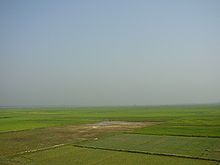Hakaluki Haor was designated an Ecologically Critical Area (ECA) by the Director General of the Department of Environment, as the ecosystem is considered to have reached a critical state. It also is a protected Ramsar site[3] of international importance for the conservation and sustainable utilization of wetlands.
The surface area of Hakaluki Haor is 181.15km2, of which 72.46km2 (40.01%) is within the territory of Barlekha Upazila. The haor is partly under the jurisdiction of Barlekha Upazila.



No comments:
Post a Comment